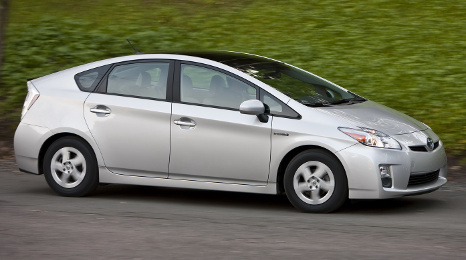Auction sales volume wasn’t quite as heavy in June as it was in May, but there was still a good bit more units pumping through the lanes this June than last.
And through the first half of the year, the late-model segment, in particular, is up close to 8 percent.
According to the latest Guidelines report from J.D. Power Valuation Services, there were 373,188 sales of cars up to 8 years old at auction last month. This is down 4.7 percent from May, but beats year-ago figures by 6.4 percent, J.D. Power said.
And this trend is even more pronounced (in either direction) for late-model vehicles, or cars that are 3 years old or younger.
J.D. Power found that there were 244,116 auction sales of late-model units last month, which is down 5.7 percent month-over-month.
While the report did not provide a year-over-year comparison for June, it did note that year-to-date auction sales volume for late-model units — which came in at a staggering 1.46 million — is up 7.9 percent compared to the opening half of 2016.
The segment leading the late-model surge is the midsize car, J.D. Power said. Its year-to-date auction sales volume through June is up 4.5 percent at 297,291 units. The firm said these cars “accounted for the lion’s share of industry volume.”
Another high-riser is the late-model compact utility vehicle, whose volume is up 28.2 percent at 218,094 units.
The newest report from AlixPartners — whose client roster includes corporate boards and management, law firms, investment banks and other kinds of investors — cautioned the industry that a “used-car time bomb” is about to explode.
AlixPartners explained that it arrived at that dire assertion through a project that began two years ago through what the firm identified as the “CASE” trends that are “completely revolutionizing” the automotive industry — the connected, autonomous, shared and electric vehicles of the not-too-distant future.
AlixPartners released this analysis detailing how automakers, suppliers and other industry players need to evolve their organizations and their partnering approaches to successfully transition to a “new automotive ecosystem.”
Using several examples, the firm detailed where companies, often relying on traditional auto-industry approaches, are falling behind and why they should consider revamping their operating models.
The report projected a significant downturn in U.S. new-vehicle sales ahead, to 16.9 million light-vehicle units this year and to a cyclical trough of 15.2 million units in 2019 — partly driven by a “used-car time bomb” of 500,000 more off-lease vehicle-returns in 2017 versus 2016, on top of the 500,000 more units in 2016 versus 2015.
The reports noted these trends will likely be a “double-whammy” to new-vehicle sales, displacing turns to cheaper used vehicles while increasing lease payments on new vehicles as leases get written with anticipated higher residual rates and tighter credit standards.
While dealerships might be turn more used vehicles, AlixPartners also mentioned that as more off-lease vehicles fill the wholesale market, firm analysts are projecting that used-vehicle prices will soften at a rate double the 13-percent drop they believe already has happened since 2014, costing captive finance companies up to $5 billion.
Beyond just the growth in off-lease volume, AlixPartners spent much effort on looking at how vehicle technology is going to impact which models might roll over the curb more quickly and which ones might need a spiff to get delivered.
On the connectivity front, the AlixPartners analysis pointed to the example of Tesla’s “high-spec” center-stack display, featuring over-the-air upgrades from the company and iPad-like features. Though this feature has been on the market since the 2012 model year, and has garnered strong reviews from consumers, AlixPartners noted that no other major automaker has moved to match the system.
On the autonomous-vehicle front, the AlixPartners analysis found there are now more than 50 major companies now working on autonomous vehicles or full autonomous-vehicle systems, as well as a plethora of smaller companies and start-ups. This “Wild-West” environment will likely result in a handful of big winners, according to the study, but on the other hand, also many disappointed investors.
The report also mentioned that many of the newer high-tech entrants have completely different “DNAs” than traditional automotive companies, including being used to high returns on capital. Given the “white-hot” competition brewing, the analysis predicts that AV systems-costs could drop 78 percent by 2025.
On the shared-mobility front, the analysis included a survey of a total of 2,000 U.S. adult consumers that showed just how fast things are changing in today’s automotive world.
The survey polled 1,000 consumers across 10 large markets where both car-sharing and ride-sharing are popular (the metro areas of Austin, Texas, Boston, Chicago, Los Angeles, Miami, New York, Portland, Ore., Seattle, San Francisco, Oakland, Calif., and Washington, D.C.) and, as a control group, 1,000 respondents across the entire U.S. This effort mirrored a consumer survey by AlixPartners in November 2013.
In this year’s survey, consumers in the 10 trend-setting markets said their awareness for virtually all major car-sharing brands (names such as Zipcar, Car2Go and Enterprise CarShare) has decreased, and 21 percent of respondents were unable to name any brands at all.
By contrast, this year’s survey also asked users of ride-sharing (brands like Uber and Lyft) in those same 10 markets about their intended usage in the next 12 months versus their past usage, and 24 percent said their usage would be more than in the past, versus just 5 percent who said less — an 18-percentage-point difference.
Meanwhile, AlixPartners said just 17 percent of car-sharing users surveyed in those markets said they would employ car-sharing more in the coming 12 months than in the past — versus 16 percent who said they would use that mobility service less in the year ahead.
Moreover, among respondents in the 10 markets, the survey found that ride-sharing was five times more likely to be a top-three transportation mode than was car-sharing (11.6 percent versus 2.5 percent), and three times more likely than traditional taxis (11.6 percent versus 4.2 percent).
In addition, among millennials surveyed in the key markets, 9 percent said ride-sharing has allowed them to postpone or avoid getting a driver’s license — what AlixPartners contends is another indicator of today’s fast-changing times.
Another key finding of the survey, coupled with AlixPartners analysis, is that in the 10 key markets each vehicle used in car-sharing is likely replacing the need for 19 personal vehicles — a decrease from 32 vehicles based on the results from AlixPartners’ 2013 survey.
Meanwhile, according to the same analysis, one vehicle used in ride-sharing is likely displacing four personal vehicles. The report went on to note that both ride- and car-sharing vehicles are typically replacing vehicles driven less than 5,000 miles per year, not typical commuting vehicles.
On the electrification front, the AlixPartners study reveals that China is investing heavily to take a leadership role in electric vehicles. In an example of that, the report noted that Chinese automakers commanded 96 percent of the 2016 market in China for full electric vehicles (not including hybrids), more than double their share (43 percent) for all types of light vehicles. It also finds that of the 103 EVs to be launched globally by 2020, 49 of them will come from China-based automakers.
The report additionally predicts that China is targeting to have two-thirds of the world’s manufacturing capacity for lithium-ion batteries by 2021 (175 GWh of power, or the equivalent of five Tesla “giga-factories”).
Meanwhile, the report recapped that hybrid sales in the U.S. have slowed, from 3.2 percent of the market in 2013 to just 2.1 percent so far in 2017, while plug-in and battery-electrics sales, while increasing, still represent only 1.0 percent of the market. This, says the study, underscores the need for maximum flexibility in both organizations and partnerships to handle the expected, but bumpy, shift to the new automotive ecosystem that’s coming.
Finally, and also in a way on the partnership front, the AlixPartners study determined that private-equity firms have switched, in droves, from being buyers to sellers — most often to “strategics” (companies in the auto industry already), as private-equity-to-strategics deals skyrocketed from 6 percent of total auto-M&A transaction values in 2013 to 84 percent in 2016.
John Hoffecker, global vice chairman at AlixPartners and a 30-year automotive veteran, said, “There’s an all-new automotive ecosystem developing, and I fear that many players really aren’t prepared for it. The changes coming are the biggest since the internal-combustion engine pushed aside horses and buggies, yet what the exact changes will be are as unpredictable as trying to guess which app is going to be most popular on next year’s smartphones.
“Leading players will be those that both study hard and are fast on their feet,” Hoffecker continued.
Mark Wakefield, global co-head of the automotive and industrial practice at AlixPartners, added, ”With the rapid but uncertain developments in connectivity, autonomy, shared mobility and electrification, traditional approaches to partnering and running organizations could well be setting up the auto industry to be disrupted.
“Fast and savvy organizations that build their own agile ecosystems and create smart partnerships, but without locking themselves into technologies that may become quickly outdated, will be best positioned to afford the needed ‘CASE’ investments of the future and to prosper from the coming industry changes rather than being rolled over by them,” Wakefield went on to say.
Your credit is good and the lease contract on your 2015 vehicle is about to expire: what are your options? You could choose to pay the residual and keep your current ride. You could trade the vehicle for a new one or for an alternative used car. Finally, you could hand in the keys and wait for the bus to take you back home.
When thinking about the effect of the ongoing surge in off-lease volume, it is important to keep these options firmly at the front of mind. Market participants are right to fret about the possible effects of off-lease volume, but not for the reasons usually put forward. Returning an off-lease vehicle certainly causes an increase in supply but, usually, it also generates demand for a replacement vehicle.
Determining the manner in which these forces balance is not a straightforward exercise. One could argue that if the customer leaves with a higher valued vehicle, there has been a net increase in demand because of the transaction. Yesterday the customer was happy driving a $10,000 car. Today they are driving a $20,000 car, therefore they have demanded “more” car. If the client leaves on foot, or in a lower valued vehicle, the net result is an increasing supply to the market. Most commentators, when considering the ongoing surge in off-lease volume, ignore this complexity, recognizing the car entering the lot but ignoring the one that leaves.
The other point is that the distinction between the new and used markets for cars, at least on the demand side, is a fine one indeed. The last time I bought a car, I entered the dealership determined to buy a used Jeep Wrangler. That I drove away in a brand new one suggests either that relative prices were favorable or the sales person was very good at their job. If a sucker, like myself, is enticed to switch to a new car, the used car market does not really suffer. There exists only a market for cars, and players in this space would, frankly, rather sell you an expensive new one than a cheaper old one. If someone swaps their used off-lease vehicle for a new one, this transaction is a positive outcome for all players in the auto industry.
In reality, only three factors unambiguously affect the overall supply of cars in the economy and hence the prices we expect for cars for a given level of demand. The factors are domestic new production, net imports of new and used vehicles, and the rate at which older vehicles are retired from service.
The first two of these factors are easy to quantify using readily available statistics. Compiling data from various trade sources, we find that real net vehicle imports grew by 20.4 percent in 2015 before slowing to 5.8 percent in 2016. Domestic production, meanwhile, continued its slow secular decline that began immediately after the recovery from the Great Recession. The number of cars manufactured in the U.S. fell by 2.1 percent in 2015 and by 5.9 percent last year. These figures should be viewed in the context of consecutive record new vehicle sales numbers over the past two years. If we assume that imports and home-grown cars are roughly equally prevalent, we find that there was a surge in vehicle supply in 2015. This surge was driven primarily by a climbing greenback, but 2016 was basically a wash.
New vehicle manufacturers from around the world might be tempted by the surge in off-lease volume to increase production relative to baseline. People returning three year old leased cars, after all, have recently demonstrated a willingness and an ability to drive a new car away from a dealership. Carmakers know that these people are prime prospects because they need wheels the moment the keys are returned. If this sales strategy is unsuccessful, which happens if non-traditional lessees return to used car ownership, we might be left with a glut of cars in the marketplace that are too new for the prevailing market.
At the other end of the spectrum, a consideration of old car retirement is also needed. We recently conducted a deep-dive on the nature of U.S. passenger vehicles by considering the most recent Consumer Expenditure Survey, conducted in 2015. Respondents were asked about the vehicles they owned and model years were recorded. We can use these data to determine, with some precision, the age profile of the U.S. vehicle fleet.
In 2008, on the eve of the Great Recession, 42 percent of vehicles owned by Americans were ten or more years old. By 2015, in contrast, a full 52 percent of vehicles had been around for a decade or more. The aging fleet is partly due to ongoing improvements in production standards. The numbers also suggest, though, that there are lots of clapped out cars on the road that are due to be retired. By our calculations, the number of vehicles entering retirement each year grows by 25 percent between 2013 and the high-water mark that arrives in 2019. This high rate of vehicle retirement represents a reduction in supply that helps to cushion any increase in production at the new end of the pipeline.
The other startling feature is the dearth of autos in the 5- to 9-year-old range — vehicles that were introduced to the market during the depths of the recession. In 2008, 34.6 percent of cars fell in this band but had fallen to only 24.6 percent by 2015. If lessors are currently feeling the heat, it is nothing compared to the inferno they will face if they are currently originating large volumes of three-year leases. The rate of vehicle retirements plummets in 2020 as the thin cohorts hit peak retirement age. This inevitable process yanks away the cushion from the vehicle supply chain.
To summarize, we currently have lots of new cars, lots of old cars, and very few middle aged cars in the national fleet. This situation leads to some interesting dynamics in the pricing of automobiles. For one thing, the prevalence of lightly used cars means that new vehicle manufacturers have very little pricing power. We have seen new vehicle sales fall markedly this year, and generous incentives have been offered to move stock.
We have also seen significant compression in used car prices. This can be seen, for example, in the average of all wholesale transactions for 0-3 year old vehicles from the NADA Auction.net database. Our analysis shows that prices of light trucks have fallen by 3 percent since their peak value in 2011, while car prices have declined by a full 13 percent. In contrast, 4- to 6-year old cars have fallen by only 4 percent while older trucks have surged higher by 10 percent. In other words, relative discounts one might expect when purchasing an older vehicle have declined considerably. People who are in the market for a 5-year old car are finding that they can get a 3-year old version without spending much more money.
So, where does all this analysis leave us? It is the combination of too much production and insufficient demand for new vehicles that is depressing newer car prices. It is not that there are too many cars in the market alone. Production (which includes imports) has shown signs of slowing, suggesting that manufacturers have worked to curtail the emergent glut of new cars.
Financial interests are far more exposed to prices of new and slightly used cars than they are to prices of older cars and clunkers. Markets are therefore watching the auto industry closely for signs of strain.
When thinking about car prices, close attention should be paid to the nature of vehicles being driven; the manner of their financing is rather less consequential.
Tony Hughes is a managing director at Moody’s Analytics, where he leads the development of used-car price forecasts. Hughes also conducted a webinar about this topic with Auto Remarketing earlier this year that’s available here.
Compared to the previous four-week period, J.D. Power Valuation Services determined auction sales volume for used vehicles up to 8 years old dropped by 3 percent in May, settling at 366,212 units.
According to the June edition of Used Car and Light Truck Guidelines Industry Update, J.D. Power Valuation Services recapped that the volume figure for the same month last year came in at 360,394 units.
Analysts determined that late-model vehicle volume — units up to 3 years old — ended up flat in May versus the previous month as they put the figure at 210,426 units. Through the first five months of the year, late-model vehicle volume sits at 1,235,897 units. The report puts the increase for this metric at 7 percent, as the year-to-date sum a year ago was 1,158,234.
At the segment level, analysts from J.D. Power Valuation Services — formerly NADA Used Car Guide — noted that late-model compact car volume rose 6 percent month-over-month in May while large pickup and midsize car volume grew by 2 percent and 1 percent, respectively.
Subcompact car volume softened by 3 percent, according to the report, which also mentioned midsize pickup and midsize van volume dropped by 4 percent and 10 percent, respectively.
If you have certified pre-owned units with alternative powertrains, the spring issue of Perspective from J.D. Power Valuation Services (formerly NADA Used Car Guide) offered some insight into why it might be difficult to turn that vehicle.
Before it became that CPO model, J.D. Power analysts explained that alternative segments generally have weaker demand and higher incentives than their gasoline-powered counterparts on the new side of the market.
“These two hindrances carry over directly to the used market, which means prices of used alternative powertrain models fall at much higher rates than for their gasoline counterparts,” analysts said in the report.
“The higher rate of depreciation means electric vehicles, plug-in hybrid and traditional hybrid retained value is frequently inferior to competitive gas models,” they continued.
Looking at the most recent 3-year-old retention figures by powertrain type (3-month average from March to May of this year), analysts noticed gasoline equipped models have retained at a rate of 52.1 percent, followed by hybrids at 46.4 percent.
Trailing much further behind, J.D. Power found that plugin hybrid and electric vehicle value retention reached 36.9 percent and 26.9 percent, respectively.
“Looking back, 2016 and 2015 retention results for the same period were similar. However, electric vehicle retention was more volatile because of new models being added,” analysts said in the report, which can be downloaded here.
Impact of fuel prices
J.D. Power also mentioned that what consumers are paying at the pump isn’t giving them much of an incentive to take that CPO unit off your store’s hands.
Analysis cited the forecast from the U.S. Energy Information Administration (EIA) that predicted fuel prices are expected to grow from roughly $2.30 per gallon in February to $2.51 per gallon in July before falling to $2.24 per gallon by December. Looking further out, the EIA expects prices to average $2.40 per gallon in 2018 and $2.44 per gallon in 2018.
“With average regular grade gas prices expected to remain around or under $2.50 per gallon in the U.S. over the short-term, there is little reason to believe that buyers who are sensitive to high gasoline expenses will be inclined to choose an alternative powertrain vehicle over a traditional gas-powered automobile due to the cost of fuel,” J.D. Power said in the report.
“However, it’s entirely possible that even with low gas prices expected in the coming years, some environmentally conscious consumers will continue to actively purchase electrics or plug-in hybrids,” analysts added.
Late-model auction sales volume in the first third of the year is still up 7 percent, but it slowed last month.
According to the Used-Car Light Truck Guidelines report from J.D. Power Valuation Services, there were 244,381 auction sales of late-model vehicles in April.
That’s down 7 percent month-over-month and off 1 percent year-over-year.
That said, there have been 955,447 late-model auction sales year-to-date through April, which is up 7 percent, J.D. Power said.
Leading that crowd is the midsize car segment. Its late-model volume is at 179,500 units year-to-date, an 8-percent increase.
Compact utilities (141,800), compact cars (131,600) and midsize utilities (103,400) are also above the 100,000-unit auction sales threshold for the year.
The biggest increase through four months has been the luxury compact utility vehicle, whose late-model auction sales volume is up 51 percent at 12,600 units, according to J.D. Power.
Midsize pickups are also a high-riser in the late-model sector, with auction sales (8,800) up 43 percent through four months.
Luxury midsize cars (down 27 percent) have shown the highest decrease in year-to-date auction sales volume of late-model vehicles, followed by subcompact cars (12 percent), luxury compact cars (11 percent), large cars (10 percent) and compact cars (4 percent).
All other segments are up.
Late-model units are those 3 years or younger.
As far as auction sales volume of vehicles up to 8 years in age (for the month of April alone), that figure was relatively steady year-over-year at and down 8 percent month-over-month at 366,909 units, J.D. Power said.
As vehicle values remained relatively steady, multiple Black Book representatives walking the lanes with dealers last week noticed consignment volume softened.
Before going into those observations, here are the numbers from the latest Black Book Market Insights report. Editors indicated car segments decreased value slightly last week, but overall both cars and trucks held fairly steady.
Out of both car and truck segments, Black Book noted compact vans performed the strongest, increasing in value by 0.89 percent.
According to volume-weighted information, editors computed overall car segment values decreased by 0.27 percent last week. In comparison, the market values had increased on average by 0.14 percent per week in the previous four weeks.
Within car segments, Black Book found that compact car and midsize car segments performed the worst, dropping by 0.89 percent and 0.44 percent, respectively.
Again looking at volume-weighted data, editors determined overall truck segment values — including pickups, SUVs and vans — increased by 0.10 percent last week, better than the average increase of 0.02 percent per week in the previous four weeks.
“The wholesale market held steady last week with stable values across most segments. Auction consignments were reported to be low for this time of the year,” said Anil Goyal, senior vice president of automotive valuation and analytics.
The consignment discussion came from Black Book representatives stationed throughout the country. Let’s start in the East and move to the West.
—From Pennsylvania: “Consignment was down a bit. Rental returns along with repos and lease returns dominated the auction. There were more bidder badges issued than normal.”
—From Indiana: “A good sale but consignment is still down. Nice, used vehicles are scarce, so the prices should remain strong on the clean and extra clean units.”
—From Washington: “Low number of consigned vehicles and a lot of high mileage or damaged vehicles. Even so prices were steady or even up slightly.”
While not mentioning dealer consignment, Black Book’s other two lane watchers to report back to headquarters had these observations:
—Out of Arizona: “Two good auctions here this week. Cars and trucks were bringing all the money.”
—Out of Michigan: “Late model year trucks with average or fewer miles are doing very well. The money on those units remains strong.”
Auction sales volume in March was steady with year-ago figures and dipped 2 percent sequentially, according to the latest Guidelines report from J.D. Power Valuation Services.
Showing a particularly sharp increase in the auction lanes was the late-model compact utility vehicle.
Overall, there were 384,704 auction sales of vehicles up to 8 years in age, which was off from the prior four-week period but consistent with the 379,182 sales in March 2016.
As far as late-model used vehicles, there was a 1-percent month-over-month increase and a 3-percent year-over-year jump in auction sales volume, the report said. First quarter late-model auction sales volume climbed 8 percent.
(Vehicles up to 3 years old are considered late-model.)
Auction sales volumes for late-model subcompact and compact cars were down 5 percent year-over-year in March, on average, and midsize cars were up by 12 percent, J.D. Power said. Compact utility vehicles showed a 30-percent lift in auction sales volume.
Looking ahead, overall used-car supply is forecasted at 13.3 million units for 2017, according to an analysis released Tuesday by ALG. That’s expected to swell about 8 percent over the next three years, coming in at 14.4 million units in 2020.
Luxury used-vehicle supply will likely see about an 18 percent uptick in the next three years, with mainstream supply increasing approximately 6 percent, according to ALG. This is driven by the faster growth in luxury on the new-car side.
According to the latest Guidelines report from J.D. Power Valuation Services, auction sales volume of models up to 8 years old rose just 1 percent over the four-week period ending Feb. 27 compared to the previous four-week period. The volume rise included 379,700 units.
Analysts determined volume for the cohort was also essentially unchanged from levels recorded over the same period last year. They added that late-model vehicle volume (units up to 3 years old) increased “substantially” in February, rising 6 percent to nearly 222,000 units.
Volume for this age group was also 5 percent above February 2016 levels.
The report mentioned more significant monthly increases occurred for subcompact and compact cars (up 12 percent) and large cars (up 13 percent). At the opposite end of the spectrum, luxury midsize car sales volume fell 4 percent while luxury midsize utility volume was off by 15 percent versus January.
In share terms, J.D. Power indicated cars represented 55 percent of late-model auction sales volume over the period, up from 54 percent in January.
“It’s worth noting that car share of new-vehicle sales was just 37 percent in February,” analysts said via Guidelines.
J.D. Power closed by noting sales volume of models up to 8 years old was up nearly 5 percent over the first two months of the year versus the same span in 2016, while late-model volume was 10 percent higher.
On Tuesday, Black Book released its latest insights white paper titled, “Data Analytics: Critical for Driving Today’s Automotive Decisions.” Officials highlighted the paper offers an in-depth look at the role data analytics are now playing for automotive professionals and how they can be used to make more profitable business decisions.
Ever since the recession, Black Book pointed out that used-vehicle prices increased and stabilized at levels not seen in years, resulting in low depreciation rates. And while depreciation is finally beginning to accelerate, analysts noticed the stabilization of used-vehicle prices has been impacted by the industry’s increased use of data analytics.
Black Book said automotive decision-makers are going beyond vehicle pricing information to better understand data specifics that touch details found in seasonality, as well as regional considerations. This closer look at the data is helping to make more insightful decisions on everything from remarketing and pricing, to incentives and inventory levels.
The new Black Book white paper is geared to help automotive professionals ascertain a better understanding of the role data analytics are playing in the broader automotive industry, specific types of analytics being utilized, as well as individual examples of how data analytics are already being used to make smarter decisions.
In the white paper, Black Book details how data analytics is having an impact on three areas of automotive today:
—Gas prices and compact car values
—The impact ride-sharing vehicles have on vehicle depreciation
—The role “channel stuffing” plays on vehicle retention
The white paper also goes into detail about various types of analytics employed today, such as prescriptive and predictive analytics, data mining, text analytics, business intelligence and data visualization.
“What’s impressive today about data analytics is that the technology behind data is allowing us to provide an immense amount of customization and proprietary interpretation around the data to meet the needs of specific organizational goals,” said Anil Goyal, senior vice president of automotive valuation and analytics at Black Book.
“Combined with our ability to capture data in real-time, the analytics process is truly helping to fast-track intelligent decision-making environments in order to maximize profit potential and reduce losses,” Goyal continued.
Click here to download the white paper.
The white paper release arrived just days after Black Book rolled out its latest solution, Visual Analytics. Goyal explained the tool’s six main features in this report.












